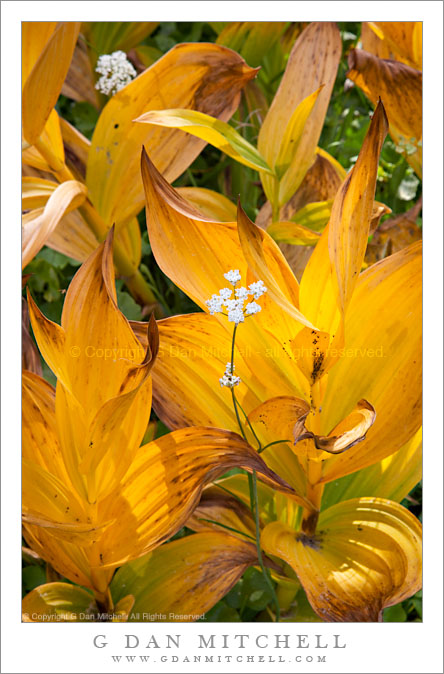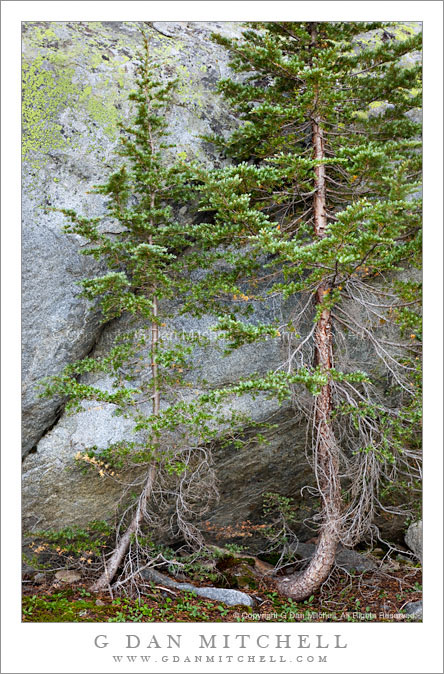I’m catching up on some online reading this evening, and thought I’d share a list of some reports on eastern Sierra fall color that I’ve come across. In no particular order:
- A quick eastern Sierra fall color update from Greg Russell/Alpenglow Images – Greg’s brief report mentions visiting the Bishop Creek area on Saturday along with visits to Rock Creek and June Lakes Loop.
- Richard Wong offers a brief report on Bishop Creek Canyon Fall Color at the California Nature Photographers blog. (Yes, my report from this weekend is posted there, too.) Richard covers several areas in the Bishop Creek and North/South/Sabrina Lakes area.
- The Eastern Sierra Fall Color group on Flickr includes a lot of recent on-the-scene photographs (you may be able to use them to make some decisions about your destination) and the discussion forum includes a lot of posts by those who are there and have been there recently. There is also an interesting thread on the all-important question of where to eat in the eastern Sierra! (Discussion forums only open to group members.)
- Elizabeth Carmel’s Landscape Photography blog points out a Sacramento Bee Interactive Guide to Fall Colors. (The guide has some interesting and useful information – perhaps most importantly a map with many great aspen locations identified. However, the interactive part of the guide would be even more useful if the information was a bit more up-to-date. I wonder if they might think about building something like this with input from a larger group of photographers who are on the scene?)
- Journal of My Travels for the Perfect Photo, Inge Fernau’s photography blog, has lots of good advice and reports on photographing Sierra aspens.
- It looks like Carol Leigh may be updating her Fall Color in California page once again. This is one of the “classic” sites for locating information about this topic, and typically includes lots of reports from those in the field. (I’m wondering though, if it is a bit less current than in the past. (I recently sent an update last week and it never appeared on the page…)
- Greg A. Lato has posted a sequence of three posts about his visit to the eastern Sierra. Visit his latoga Photography site and then look for the “recent blog posts” section lower on the page.
- Leon Turnbull reports on a visit to the giant aspen groves at the top of Monitor Pass and a perhaps unfortunate abundance of certain other travelers while he was there. (The groves atop Monitor Pass are huge, and seem to me to be a bit less well-known than some of the areas further south. I was a bit surprised at his report that many of the trees had not yet changed colors, since I frequently find that they change here just a bit earlier than in some other locations on my circuit. A good aspen route is to go up over Carson Pass and then over Monitor to highway 395.)
- The Life on the Eastern Slope blog mentions conditions in Lundy Canyon, Tioga Pass, and other nearby areas. (I drove past but did not enter Lundy Canyon on Sunday – I could see colors up high above Lundy, but cannot offer first-hand info on conditions down in the canyon. I also went over Tioga Pass twice and saw some pretty good colors just east of the pass, though colors down in Lee Vining Canyon have not changed yet.)
- I mentioned it earlier, but it is worth mentioning that Michael Frye posted a bit of a guide to photographing fall colors in Yosemite. (For the record, if you are looking for great aspen photography opportunities, Yosemite is not your best choice. But there are other types of fall color in Yosemite that bring me back every year.)
- Greg Boyer has posted his Fall Color Update #8 from Bishop. His view is that this coming weekend will likely be the prime time to shoot – which is pretty much in line with what I’m thinking. I would not be surprised to find that some areas in the upper Bishop Creek drainage will have lost leaves by then, but there are tons of trees a bit lower… and many other eastern Sierra areas should be in great shape. (But watch the weather – there is a chance of a change this weekend.) Other entries at Greg’s One Horse Studio blog also offer good information and perspectives on fall color.
Whew! I’m sure I’ve missed some other useful resources – feel free to share via a comment.


